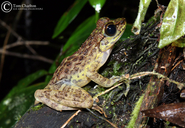|
Amolops larutensis (Boulenger, 1899)
Larut Torrent Frog | family: Ranidae genus: Amolops |
 © 2019 Tom Charlton (1 of 16) |
|
|
|
Description As a tadpole: A. larutensis, like all Amolops, has an abdominal sucker which extends from the lip past the middle of the abdomen (termed gastromyzophorous). Jaws are somewhat serrated and undivided. A. larutensis larvae is about 65 mm in length (Boulenger 1912). Distribution and Habitat Country distribution from AmphibiaWeb's database: Malaysia Malaysian region distribution from AmphibiaWeb's database: Peninsular Malaysia
Life History, Abundance, Activity, and Special Behaviors Comments
References
Boulenger, G. A. (1912). A Vertebrate Fauna of the Malay Peninsula from the Isthmus of Kra to Singapore including Adjacent Islands: Reptilia and Batrachia. Taylor and Francis, London. Dring, J. C. M. (1979). ''Amphibians and reptiles from northern Trengganu, Malaysia, with descriptions of two new geckos, Cnemaspis and Cyrtodactylus.'' Bulletin of the British Museum (Natural History), 34(5), 181-240. Smith, M. A. (1930). ''The Reptilia and Amphibia of the Malay Peninsula.'' Bulletin of the Raffles Museum, 3(i-xvii), 1-149. Sukumaran, J. (2002). ''Frogs of the Malay Peninsula.'' http://frogweb.org/. Taylor, E.H. (1962). ''The amphibian fauna of Thailand.'' University of Kansas Scientific Bulletin, 43(8), 265-599. Van Kampen, P. N. (1923). The Amphibia of the Indo-Australian Archipelago. E. J. Brill, Leiden. Originally submitted by: Veronica Garza (first posted 2004-03-18) Edited by: Tate Tunstall (2004-04-21) Species Account Citation: AmphibiaWeb 2004 Amolops larutensis: Larut Torrent Frog <https://amphibiaweb.org/species/4650> University of California, Berkeley, CA, USA. Accessed May 31, 2025.
Feedback or comments about this page.
Citation: AmphibiaWeb. 2025. <https://amphibiaweb.org> University of California, Berkeley, CA, USA. Accessed 31 May 2025. AmphibiaWeb's policy on data use. |



 Map of Life
Map of Life